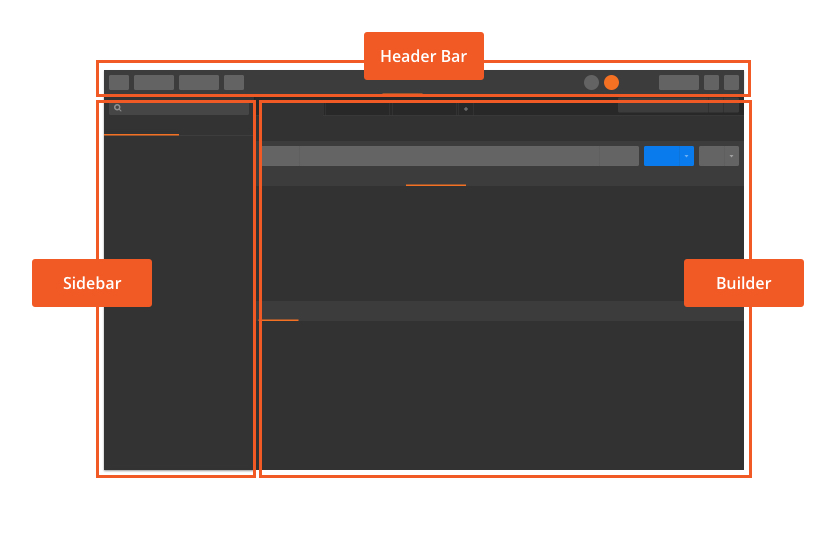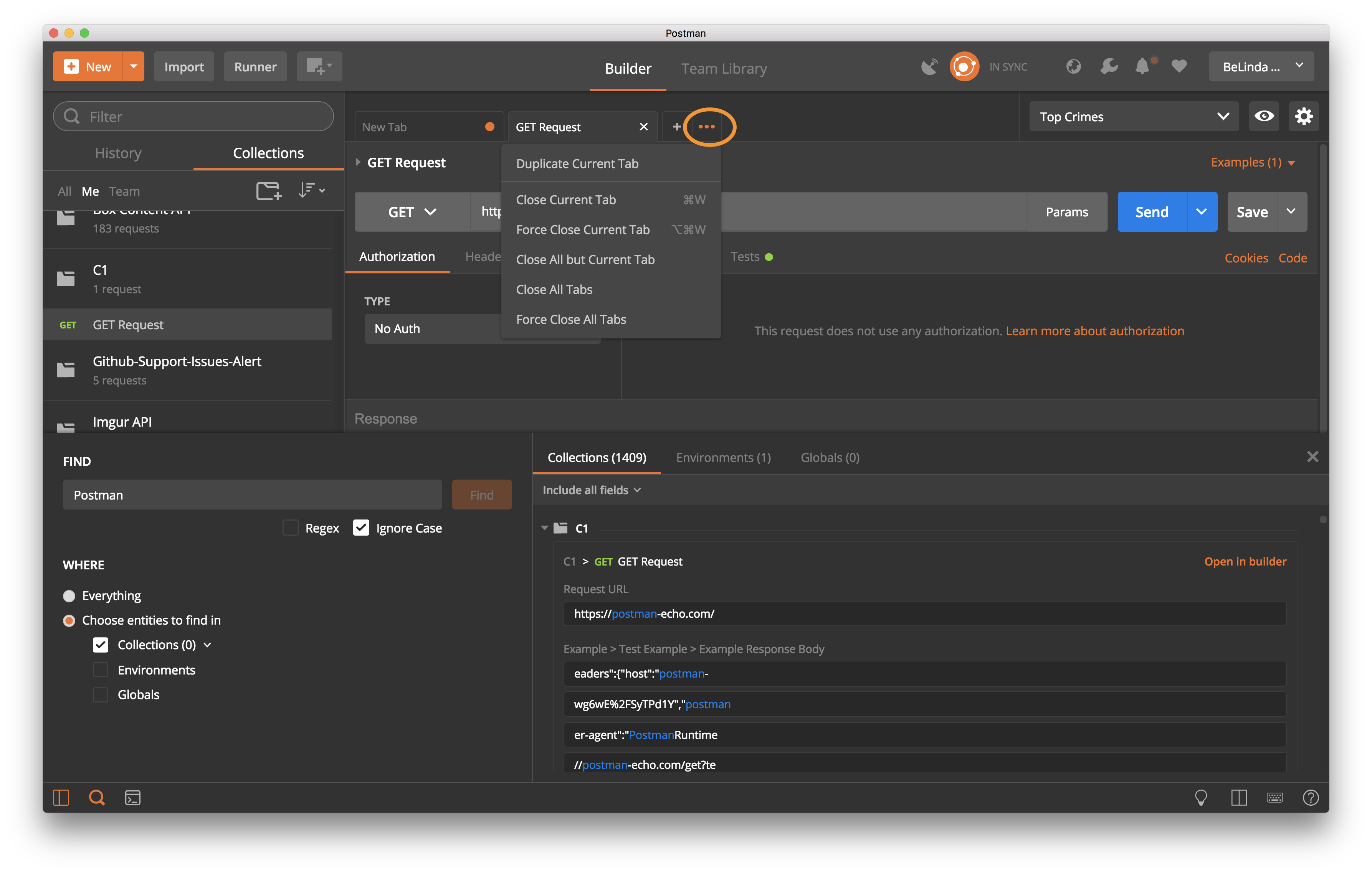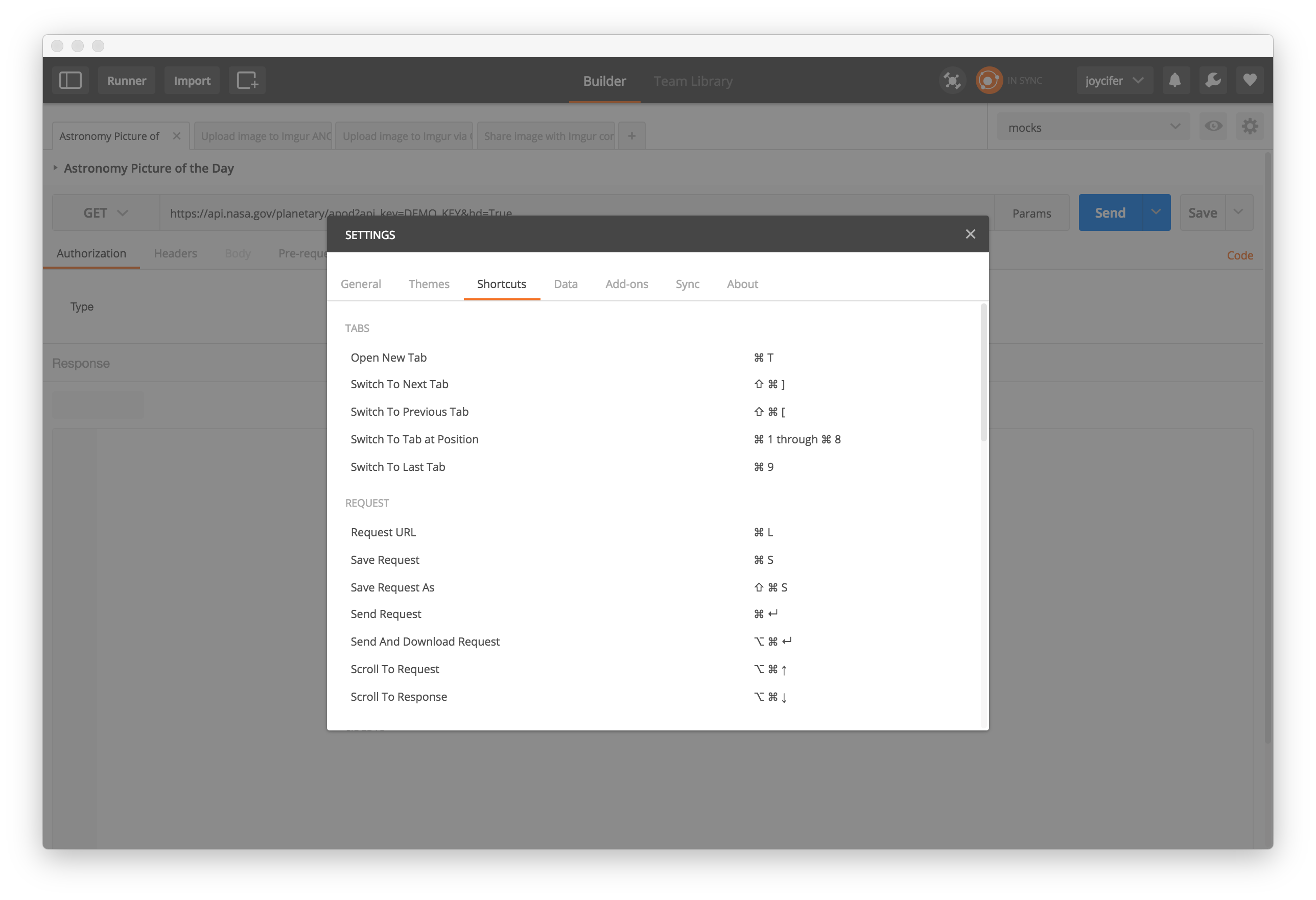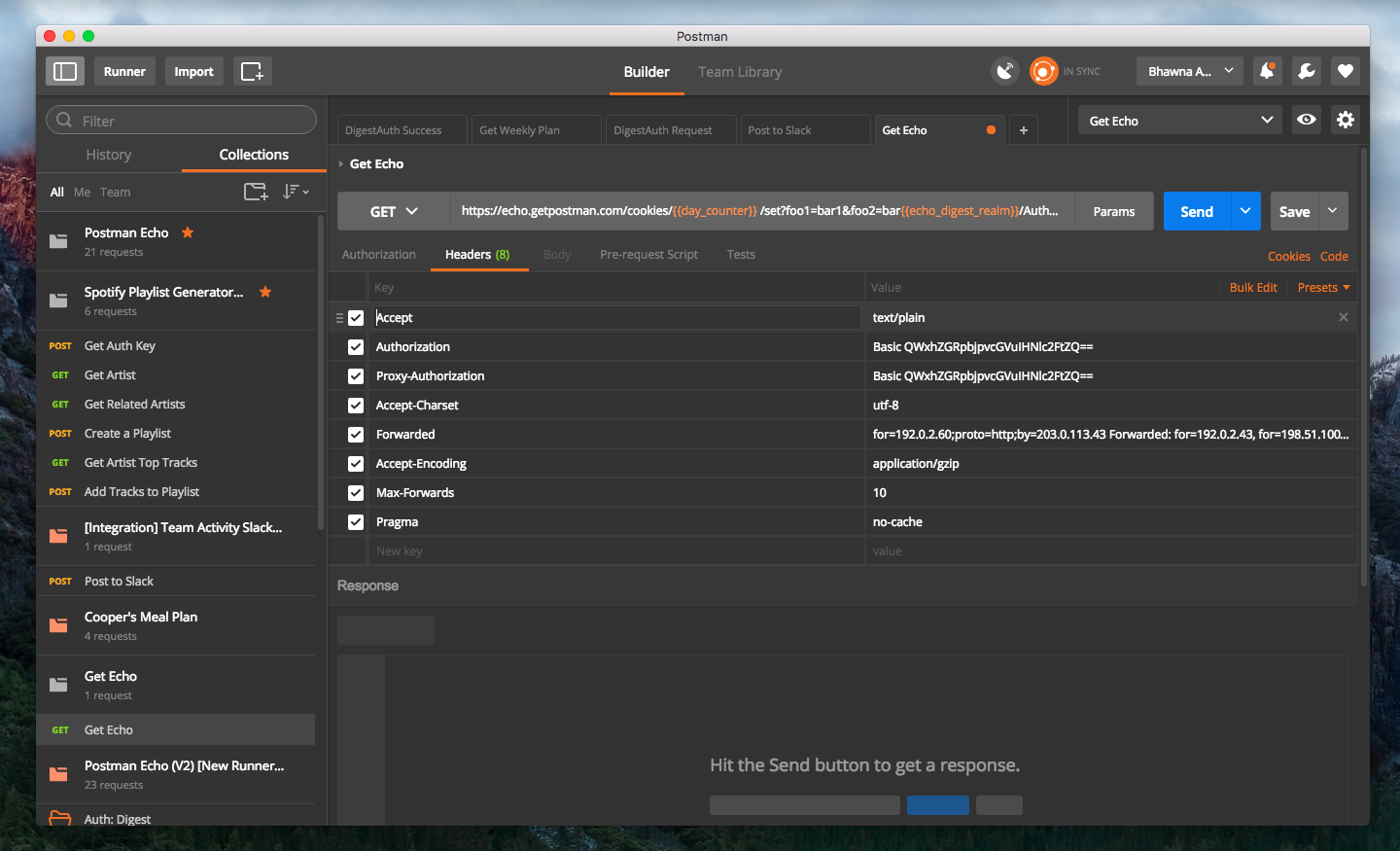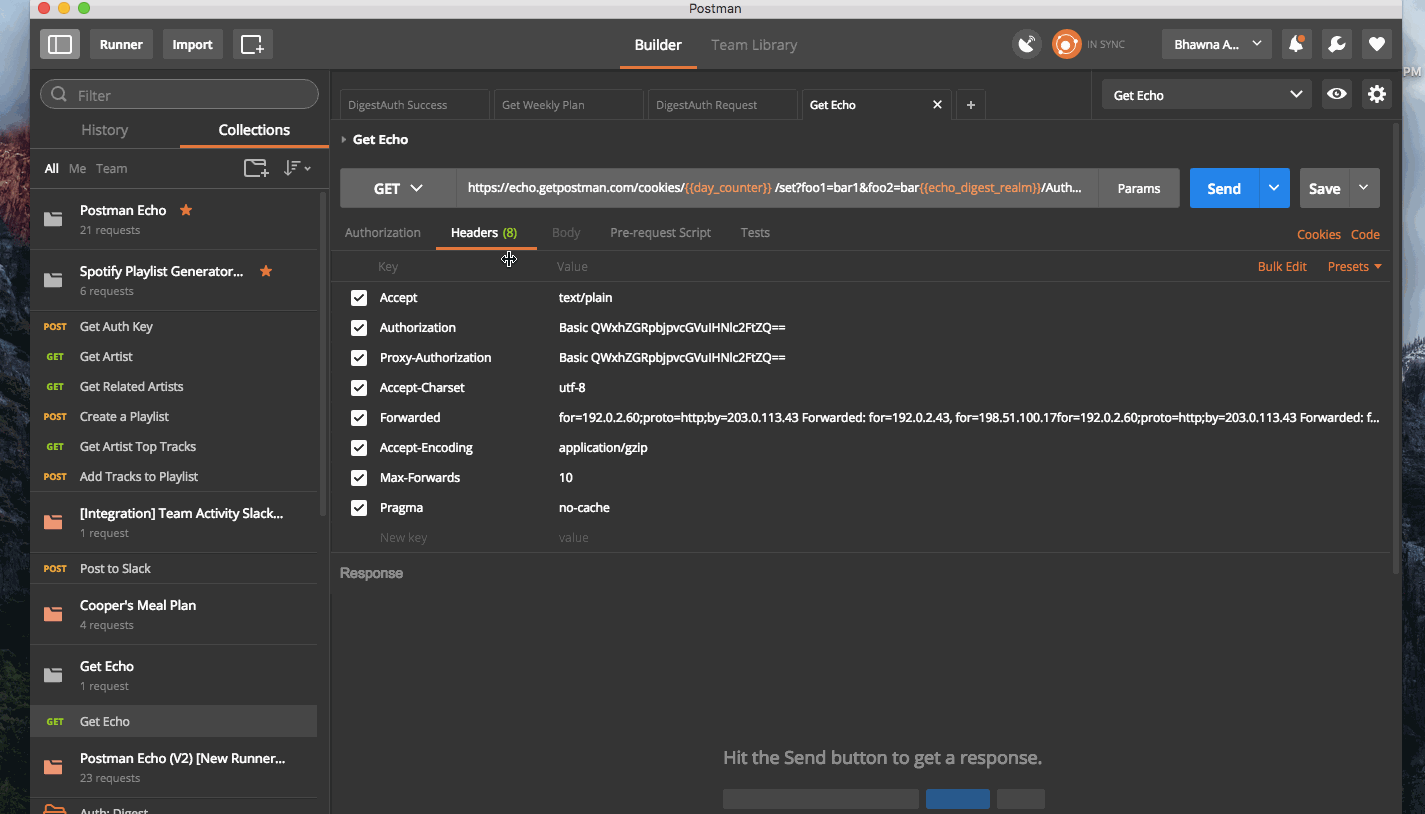浏览 Postman
Postman 提供了一个多窗口和多标签界面让你使用 API??。这种界面设计为您的 API 提供了尽可能多的空间。
侧边栏
侧边栏方便你查找和管理请求和集合。侧边栏有两个标签:History 和 Collections.
您可以拖动右边缘来调整侧边栏的宽度。您还可以最小化小屏幕的侧边栏,并在状态栏中显示或隐藏侧边栏.
History 选项卡
Postman 将您发送的每个请求保存在侧边栏的 History 选项卡中. 学习了解 history.
Collections 选项卡
在侧边栏的 Collections 选项卡中创建和管理集合. 学习了解 collections 以及它们如何加速 API 的速度.
标题栏
顶部的标题栏包含以下选项:
- New 按钮: 创建请求,集合,环境,文档,模拟服务器和监视器。
- Import 按钮 - 使用文件, 链接或者文本将 Postman 集合, 环境, WADL, Swagger, RAML, or cURL 导入 Postman.
- Runner 按钮 - 查看 collection runner.
- 新窗口图标 - 打开一个新的“Tab”, “Postman Window”或“Runner Window”.
- Builder 和 Team Library 选项卡 - 在请求生成器和团队库之间切换.
- 拦截器/代理 图标 - 管理代理或拦截器设置。
- 同步状态图标 - 更新 Postman 账户的状态.
- 公共 API 库 - 显示公共API网络.
- 设置图标 - 管理 Postman 应用程序设置并查找其他支持资源.
- 通知图标 - 接收通知或广播.
- 心形图标 - 喜欢 Postman 吗? 点击这个按钮分享爱!
- 用户下单菜单 - 显示当前用户并提供以下选项:“配置文件”,“帐户设置”,“通知首选项”,“活动会话”和“添加新帐户”.
生成器
Postman 生成器为您提供了一个选项卡式的布局来发送和管理构建器中的API请求. 上半部分是请求生成器,下半部分是响应查看器.
- Cookies - 你可以使用 Save 按钮下的 Cookies 链接来访问 MANAGE COOKIES 模式. 该功能可让您管理与请求相关联的Cookie. 详细了解 使用 cookies.
- Code - 您可以使用 Save 按钮下最右侧的 Code 链接来访问 GENERATE CODE SNIPPETS 模式. 通过此功能,您可以使用20多种语言生成与请求关联的代码片段。
控制台
Postman 有两个控制台可以看到幕后发生了什么. 了解更多 使用控制台日志排除问题.
- Postman 控制台 - 包含 HTTP 请求和响应的运行日志. 你可以使用脚本记录消息 (例如 console.log). 此功能仅适用于 Postman 的本机应用程序.
- DevTools 控制台 - 在开发过程中提供诊断信息. 要了解如何访问DevTools控制台日志,请参阅 调试和日志.
菜单栏
Postman 应用程序菜单栏提供对其他功能的访问. 请注意,Postman 原生应用程序的菜单栏和Postman 的 Chrome 应用程序之间有一些区别.
Postman 原生应用程序: 显示更多菜单选项以访问 Postman 特定的功能。
Postman Chrome 应用程序: 由于 Chrome 标准限制,显示较少的菜单选项。
状态栏
Postman 界面底部的状态栏为您提供了一种便捷的方式:
当你单击 Help & Feedback 图标时, 你可以看到一个菜单,提供最新发布说明, 文档, 安全性, 支持, and 社交媒体的访问.
选项卡和窗口
Postman 让你使用多选项卡和对窗口配置来处理请求. 甚至可以同时进行多个请求.
要在 Postman 中打开新选项卡,请按下生构建器中的 + 图标或使用 CMD/CTRL + T 快捷键. 从菜单栏中, 您也可以从 File 菜单中选择“New Tab”来创建一个新选项卡。
当您右键单击一个选项卡名称时, 该菜单允许您复制或关闭选项卡. 如果任何选项卡在尝试关闭选项卡时有未保存的更改,Postman 会提示您保存更改。
Busy tabs
The idea behind busy tabs is to make sure people don’t lose the request they’ve been working on, even if it isn’t in a collection. When you’re on a busy tab, opening a new request from the sidebar will open the request in a new tab. It does not replace or interfere with the request in the previous busy tab.
What makes a tab busy? Working on a tab moves the tab into a busy state. For example, receiving a response or making changes that are not yet saved (reflected by an orange dot on the tab) will all result in making a tab busy.
选项卡和侧边栏行为
默认情况下, Postman 假定您想在一个选项卡中处理一个请求集合. 当您从侧边栏打开请求时, Postman 在现有选项卡未保存更改时打开新选项卡, 如果不是,请求将在当前选项卡打开. 在侧边栏的 Collections 选项卡中,右键单击一个请求并选择Open in New Tab”,这样你可以始终在新选项卡中打开一个请求.
选项卡菜单
邮差提供了几个选项卡操作,以帮助您管理您的工作。
要访问选项卡菜单,请单击标签右侧的三个点。出现下拉菜单,其中包含管理选项卡的选项。
- 复制当前选项卡
- 关闭当前选项卡
- 强制关闭当前选项卡
- 关闭除当前选项卡外其他所有选项卡
- 关闭所有选项卡
- 强制关闭所有选项卡
当您“强制关闭当前选项卡”或“强制关闭所有选项卡”时,选项卡会立即关闭,而不会提示您将工作保存在选项卡中。
当您“关闭当前选项卡”,“关闭所有当前选项卡”或“关闭所有选项卡”时,将出现一个对话框,其中包含保存所做工作的选项.
移动请求
在构建器中,你可以拖拽选项卡重新排序. 在新的选项卡或者在新的 Postman 窗口中打开一个请求。你可以使用标题栏上的 New Window 图标或快捷键打开多个窗口。
键盘快捷键
Keyboard usability is high on the priority list for any dev tool. For most developers, it’s a more efficient input method, requiring minimum movement and effort compared to a mouse or other pointing device. It also saves time, and for repetitive or well-frequented tasks, this can bring about a huge improvement in speed over the long run.
When we approached assigning keyboard shortcuts in Postman, we broadly categorized them into three buckets based on their function: navigation, manipulation and global. Navigational shortcuts help you move around the interface, manipulation shortcuts allow you to manipulate the current selection and global shortcuts can be accessed from anywhere.
Navigational Shortcuts
We want to make it easier for a user to navigate quickly between elements. Let’s take the simple example of opening and sending a series of saved requests. Without a shortcut, a user selecting a request in the sidebar would use their pointer every time to open it in a tab. With the CMD/CTRL + ALT + 1 shortcut, you can now focus the sidebar from wherever you are in interface. You can then navigate to the desired request using the arrow keys. Combine this with CMD/CTRL + Enter to send a number of requests in the matter of a few seconds.
Manipulation Shortcuts
Manipulation shortcuts allow you to quickly work on your current selection and perform actions such as edit, delete and duplicate. Combined with navigational shortcuts, this makes creating and organizing collections in your sidebar a breeze. These shortcuts can also be used in other list views such as our new data editor.
Global Shortcuts
Global shortcuts are used for important actions so that they can be accessed irrespective of the element in focus. Actions on your selected tab, like Save (CMD/CTRL + S), Save As (CMD/CTRL + Shift + S), and Send Request (CMD/CTRL + Enter) all follow this pattern. Global shortcuts can also be used to perform UI actions like toggling the sidebar (CMD/CTRL + ), Jump to URL (CMD/CTRL + L), and Open Console (CMD/CTRL + ALT + C).
View keyboard shortcuts for your OS
Different operating systems will have different shortcuts. You can always view a complete list of your operating system’s shortcuts under the Shortcuts tab in the SETTINGS modal.
Reference for all shortcuts
TABSmacOSWindows / Linux shortcutsOpen New Tab? TCtrl + TClose Tab? WCtrl + WSwitch To Next Tab? ? ]Ctrl + Shift + ]Switch To Previous Tab? ? [Ctrl + Shift + [Switch To Tab at Position? 1 through ? 8Ctrl + 1 through Ctrl + 8Switch To Last Tab? 9Ctrl + 9Open Request from Sidebar in New Tab? ? (click)Ctrl + Shift + (click)REQUEST Request URL? LCtrl + LSave Request? SCtrl + SSave Request As? ? SCtrl + Shift + SSend Request? ?Ctrl + EnterSend And Download Request? ? ?Ctrl + Alt + EnterScroll To Request? ? ↑Ctrl + Alt + ↑Scroll To Response? ? ↓Ctrl + Alt + ↓Beautify raw Request body? BCtrl + BSIDEBAR Search Sidebar? FCtrl + FToggle Sidebar? \Ctrl + \Next Item↓↓Previous Item↑↑Expand Item→→Collapse Item←←Select Item?EnterRename Item? ECtrl + EGroup Items? GCtrl + GCut Item? XCtrl + XCopy Item? CCtrl + CPaste Item? VCtrl + VDuplicate Item? DCtrl + DDelete Item?DelINTERFACE Zoom In? +Ctrl + +Zoom Out? -Ctrl + -Reset Zoom? 0Ctrl + 0Toggle Two-Pane View? ? VCtrl + Alt + VSwitch To Sidebar? ? 1Ctrl + Alt + 1Switch To Builder? ? 2Ctrl + Alt + 2WINDOWS AND MODALS New Requester Window? NCtrl + NNew Runner Window? ? NCtrl + Shift + NNew Console Window? ? CCtrl + Alt + CImport? OCtrl + OManage Environments? ? ECtrl + Alt + ESettings? ,Ctrl + ,Submit Modal? ?Ctrl + EnterOpen Shortcut Help? /Ctrl + /
Data editor
Working with large amounts of data can be cumbersome and time consuming. Postman’s data editor lets you view and manipulate data in a fast, effective, and elegant manner.
Spreadsheet features are familiar to most people working with data, so we used them as inspiration for the design of the data editor.
Visual layout
We’ve configured the available horizontal and vertical space more effectively to optimize the data that can be displayed up front.
Relevant features will display for a specific row on hover. This reduces clutter in the interface and helps the user focus on the most relevant data.
Select multiple rows by simply dragging your mouse
Keyboard shortcuts for the data editor
Data editormacOSWindows / Linux shortcutsNavigationarrow keys (↑,→,↓,←) + Tabarrow keys (↑,→,↓,←) + TabDuplicate row? DCtrl + DSelect specific rows? (click)Ctrl + (click)Select previous rows? ↑Shift + ↑Select next rows? ↓Shift + ↓Select current row? →Shift + →Select current row? ←Shift + ←Move row(s) up? ? ↑Ctrl + Shift + ↑Move row(s) down? ? ↓Ctrl + Shift + ↓Copy - can multiselect and copy rows? CCtrl + CCut - can multiselect and cut rows? XCtrl + XPaste? VCtrl + VDelete - can multiselect and delete rows?DelDeselect rows?Esc
Support for bulk actions
You can select and copy multiple rows. Then go ahead and paste them in a different place (e.g. params) and check out what happens for yourself!
View information up front
We want to display the information you want to see up front. If you navigate to a place with a large amount of data, the UI element auto expands to show the complete information. This is implemented in the data editor as well as the URL bar.
Ability to resize columns
You can change the width of the key and value columns by dragging the boundary on the right side of the ‘key’ column header.
Multiline support
The data editor supports sending multiline values. Pressing ‘Enter’ in a key or value field expands it and takes the cursor to a new line.
